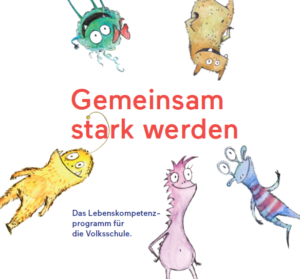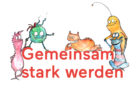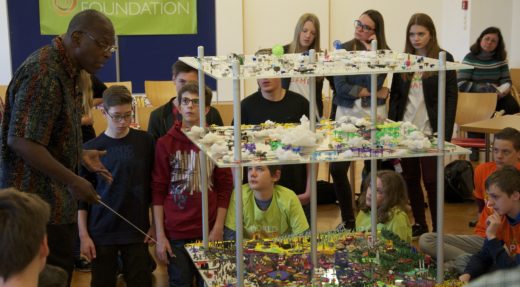“Gemeinsam stark werden” (“Becoming Strong Together”) – The Life Skills Programme for Primary Schools

“Becoming Strong Together” is a teaching programme to promote the life skills of children of primary school age (first to fourth grade). The aim is to create good conditions for a healthy, self-determined and fulfilled life.
As a universal prevention programme, “Becoming Strong Together” is based on the life skills approach of the World Health Organisation (WHO) and contributes to the prevention of addiction, violence, suicide and mental disorders.
school health promotion, life skills, existential pedagogy, personality development, prevention
Initial Situation
- Mental disorders among Austrian children and adolescents are on the rise. The prevalence rate of mental disorders in the age group from 10 to 18 is 18.9%, meaning almost every fifth adolescent is affected (Phillip, Zeiler, Waldherr et al. 2015).
- Anxiety disorders (e.g. performance anxiety, fear of failure), ADHD, aggressive-dissocial disorders, depressive disorders and autoaggressive behaviour are among the most common disorders affecting children and adolescents (HBSC Factsheet 4/09, Federal Ministry of Health).
Solution Approach, supporting scientific studies
- The strongest protective factors for stress-related health burdens among teachers and students are sustainable relationships and social support (Werner & Smith, 2001).
A sustainable teacher-student relationship has a greater long-term effect on students’ prosocial behaviour than common prevention programmes (Obsuth et al, 2016). - A good teacher-student relationship is a significant factor influencing student learning (Hattie, 2014).
- In addiction, violence and suicide prevention, as well as in the prevention of mental disorders, increasing emphasis is being placed on strengthening specific life skills (Reese & Silbereisen, 2001).
- A good school and class climate not only contributes to successful and high-quality teaching, it also promotes social skills and learning performance, and above all the health of pupils and teachers (Ramelow, Unterweger, Gugglberger & Felder-Puig, 2013).
Project description
The “Becoming Strong Together” manual includes 46 teaching units with over 200 exercises to promote these personal and social skills:
- Self-awareness and empathy
- Self-care, relaxation and enjoyment skills
- Dealing with stress and difficult emotions
- Decision-making and problem-solving skills
- Creative and critical thinking
- Communication and relationship skills
- Self-knowledge and self-assertion
- Dealing with diversity
- Ability to implement one’s own values
- Willingness to assume responsibility
The support and encouragement in these areas not only benefits any individual child but also the class as a whole. The exercises also contribute to improving the class climate.
To strengthen children’s personality development in a sustainable way, “Growing Strong Together” addresses several levels simultaneously:
- Lesson planning: provision of teaching materials
- Shaping relationships: tips for a teacher-student relationship that promotes personality development
- Involvement of parents or the social environment

The Effects
Direct results (output): improvement of the individual life skills of the pupils and the classroom climate.
Medium-term effects (outcome): prevention of problem behaviour and negative personality developments in children (e.g. addiction, aggression, anxiety, depression, ideology).
Long-term effects (Impact): reduction of health disorders requiring treatment among pupils.
Bibliography
Antonovsky, A. 1997: Salutogenese. Zur Entmystifizierung der Gesundheit. Tübingen: Deutsche Gesellschaft für Verhaltenstherapie.
Bauer, J. et al (2007). Working conditions, adverse events, and mental health problems in a sample of 949 German teachers. International Archives of Enviromental and Occupational Health, 80, S.442-449
Hattie, J. (2014). Lernen sichtbar machen für Lehrpersonen: Überarbeitete deutschsprachige Ausgabe von "Visible Learning for Teachers". Schneider Verlag: Hohengehren, Baltmannsweiler.
Hofmann, F. & Felder-Puig, R. (2013). HBSC Factsheet. Gesundheitszustand und –verhalten österreichischer Lehrkräfte: Ergebnisse der Lehrer/innen-Gesundheitsbefragung 2010. Wien: Bundesministerium für Gesundheit.
Obsuth I. et al (2016). A Non-bipartite Propensity Score Analysis oft he Effects of Teacher-Student Relationships on Adolescent Problem an Prosocial Behavior. Journal of Youth and Adolescence (Juni 2016).
Philipp, J. & Zeiler, M. & Waldherr, K. & Nitsch, M. & Dür, W. & Karwautz, A. & Wagner, G. (2015). The Mental Health in Austrian Teenagers (MHAT)-Study: preliminary results from a pilot study. Neuropsychiatrie 4, 14.
Ramelow, D., Unterweger, K., Gugglberger, L., Felder-Puig, R. (2013). Die Bedeutung des Schulklimas für die Gesundheit von Schüler/inne/n und Lehrer/inne/n. LBIHPR Forschungsbericht.
Reese, A. &Silbereisen, R. K. (2001): Allgemeine versus spezifische Primärprävention von jugendlichem Risikoverhalten. In: Freund, T. & Lindner, W. (Hrsg): Prävention. Verlag Leske und Budrich, Opladen, 139 – 162.
Werner, E. & Smith, R. (2001). Journeys from Childhood to Midlife. Risk, Resilience and Recovery. New York: Cornell. .
HBSC Factsheet 4/09, Bundesministerium für Gesundheit



